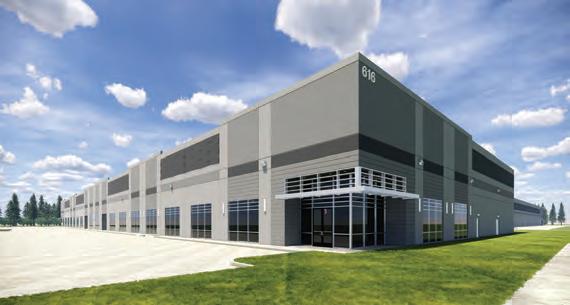
5 minute read
Pandemic compels more technology uptake on construction sites Temperature 16
Incentives in industrial: How the market shows potential during the pandemic
BY BRANDI SMITH
At our house, the doorbell rings more now than it ever did before the COVID-19 pandemic. The sound doesn’t typically announce a friendly visit from a neighbor these days. Instead, it alerts the household that our delivery has arrived, that on our doorstep awaits something as mundane as groceries or as exciting as new craft supplies for the kids. Our family is one of millions doing our best to heed recommendations from the Centers for Disease Control while also supporting the local economy. In doing so, we’re indirectly bolstering the industrial commercial real estate market.
Specializing in CRE photography, video tours, and aerial drone services
VIRTUAL TOURS For Commercial Real Estate






















TOUR OPTIONS:
Interactive 360 Panoramas
Matterport 3D Scans 4K/HD Video (Interior/Exterior) Aerial Drone Video (Exterior)
CALL TODAY 713.449.2468 www.PlusCorpPhotos.com

It’s no surprise that online sales have seen an incredible boost in the past few months. After all, most stores were completely shut down for a period, only able to offer their wares via the internet. As a result, there’s been an increased demand for warehouse, cold storage and distribution space. That need is driven in large part by the food industry, which has documented growing consumer desire to pick up grocery items or to have them delivered as an alternative to winding the narrow aisles of their neighborhood market. Daily online sales doubled between March 13 and March 15 (compared to March 1 to March 11), per Adobe’s Digital Economy Index. Before COVID-19 online grocery sales only represented 1.5 percent of e-commerce sales. They now account for more than 10 percent. Before you argue that the spike is temporary, a survey conducted by Brick Meets Click / Shopper Kit suggests that nearly half of people who are doing their shopping online intend to do so even after the pandemic is over. “The COVID-19 situation will drive further adoption of e-commerce in the future, which will require more fulfillment space and a higher demand for industrial properties,” said Jason Hsiao, managing director of Shaw Investments. “Restaurants will also evolve to incorporate omnichannel strategies and attempt to remove third-party delivery in order to maintain margins.” This is a trend market experts have been monitoring for years as more retailers leaned into the e-commerce world. Just west of Houston, industrial construction has exploded along I-10 with projects including Parkside Capital’s West Ten Business Park. The final piece of the 460-acre, masterplanned development sold to Insite Realty and joint venture partner Principal Real Estate Investors, who teamed up to develop the Cane Island Business Center, a 277,400-square-foot speculative distribution project. In its 2019 report Food on Demand Series: Cold Storage Logistics Unpacked, CBRE Research concluded an additional 75 million to 100 million square feet of cold storage space would be needed to meet the increasing demand associated with direct-to-consumer food delivery or in-store item pickup.
“Most people that sell to consumers will need to have a larger footprint to accommodate more inventory,” Walter Kemmsies, economist and chief strategist for industrial real estate firm JLL told Logistics Management. “E-commerce is on fire and the demand for industrial real estate is there to support it as well.” Another factor to consider, pointed out Kemmsies, is that America has started shifting away from China as a supplier. Doing so requires changes to the supply chain, possibly resulting in more safety stock and, as a result, the need for more storage space. Though COVID-19 has completely upended the industry, it’s also provided a spotlight for the strengths of the industrial real estate market. Just as they always have, resilient CRE professionals and their clients will adapt and respond to the challenges posed by the pandemic to capitalize on the investment opportunities the current situation promises.
Alpha Office Escalations
< Continued from Page 18 lease specifics for each tenant into AOE’s guided step-by-step profile template. After uploading or inputting operating expenses, the software instantly creates invoices. The AOE dashboard offers a high level snapshot of the building’s escalation results. The software generates an unparalleled array of simple, clean reports and invoices for ownership, management and tenants. Its standard methodology provides a valuable tool to help defend the escalation calculations in the case of a dispute, tenant audit or lawsuit.
AOE’s user support is unique to the industry. “If a customer has a question, they contact me or our programmer. They get a personal response and an immediate answer,” says Mayerhofer. People who use AOE love it, he adds, even bringing it with them when they move to a different company. Testimonials from some of the country’s biggest real estate companies echo that. "The Alpha Office Escalation program has taken the guesswork out of trying to calculate gross-ups. We've made it part of our lease process to input new tenants and renewals into AOE as they're signed, it saves a ton of time when preparing annual reconciliations,” says Karrie McCampbell, regional operations manager for Transwestern’s Central Region. “We swear by the software,” says Cushman & Wakefield senior property manager Jennifer Hatchett. “Escalations are so easy for us!" Brownfield and Mayerhofer hope their software, into which they’ve poured their knowledge, experience, time and passion, will continue to make the lives of real estate professionals a little easier. “AOE is an escalation billing system with very helpful reports for office building management, ownership and tenants,” says Brownfield. “We specialize in escalations so you don’t have to.” To learn more about Alpha Office Escalations, visit www.AlphaOfficeOnline.com.
City Management


